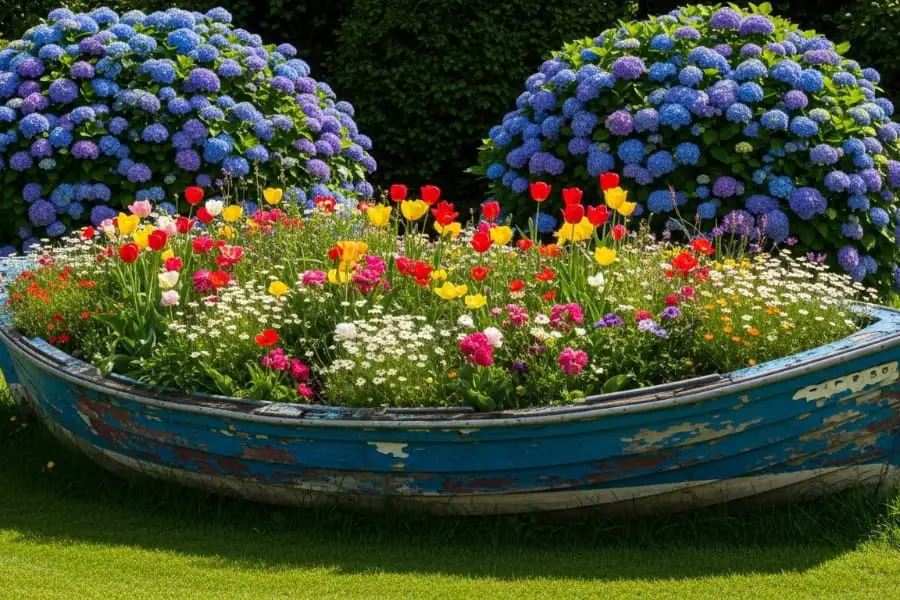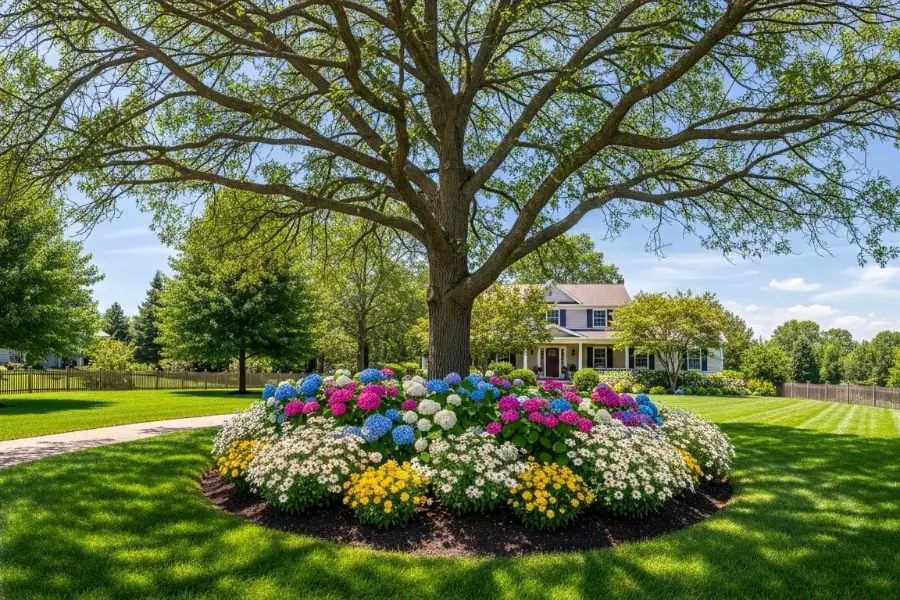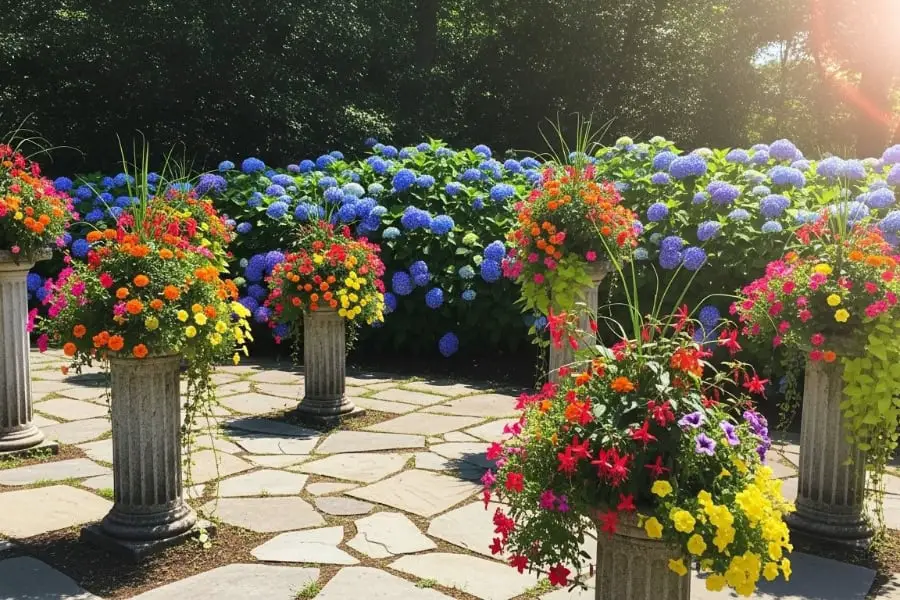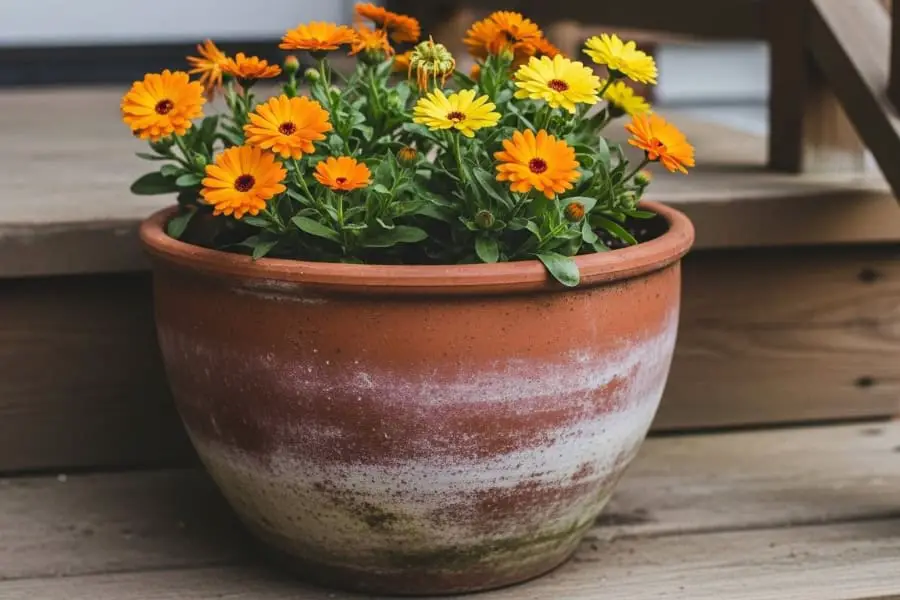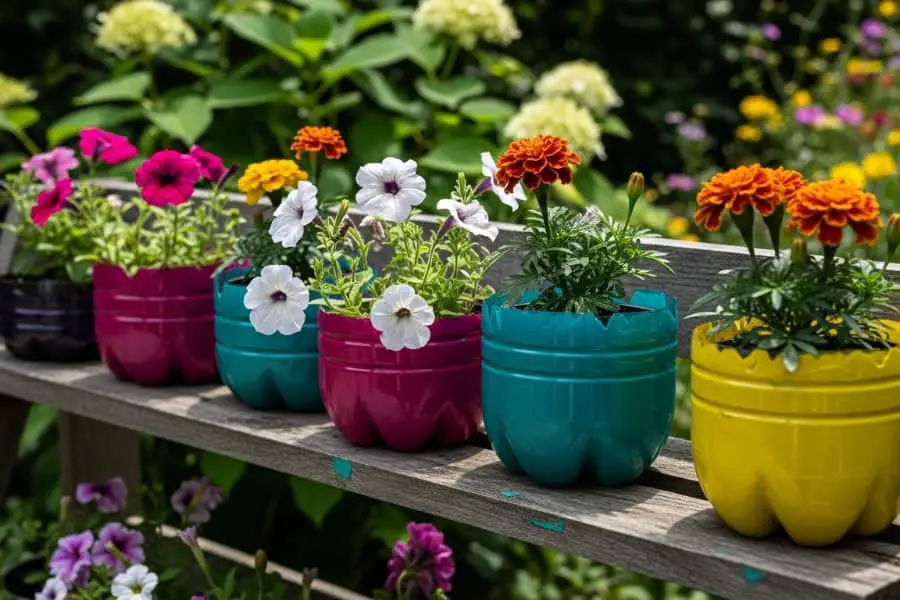
Hi,
Feeling stuck trying to make your garden stand out? Picking the right plants can feel tricky sometimes.
Hydrangeas are a great choice—they bloom in so many colors and fit beautifully in all kinds of gardens.
In this blog, I’ll share 24 hydrangea ideas to inspire you. Keep reading for tips to transform your yard!
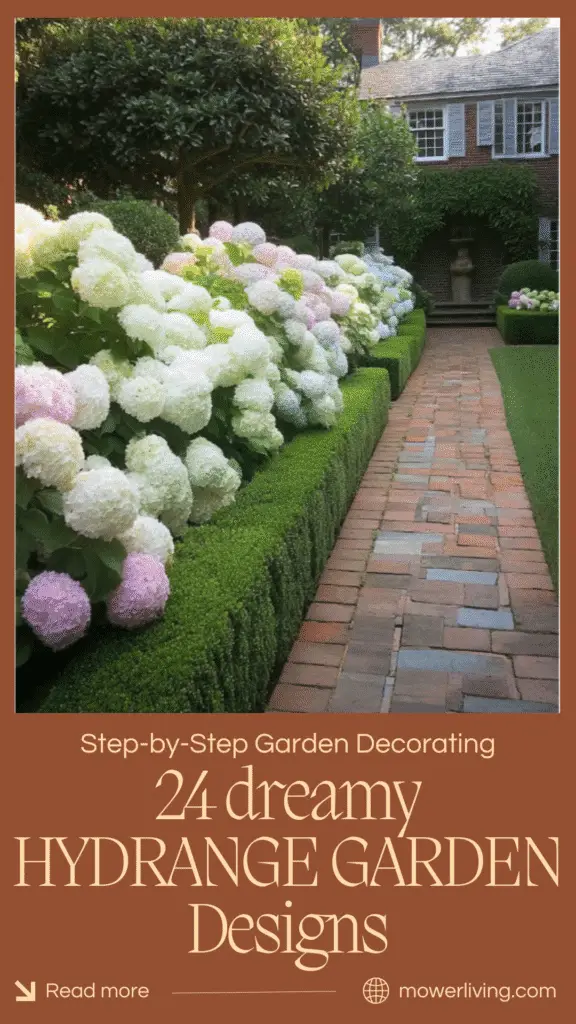
Contents
- 1 24 Hydrangea Landscaping Ideas
- 1.1 Arborvitae
- 1.2 Blue
- 1.3 Climbing Trellis
- 1.4 Allium
- 1.5 Azalea
- 1.6 Boxwood
- 1.7 Juniper
- 1.8 Lavender
- 1.9 Peony
- 1.10 Rose
- 1.11 Tall Grass
- 1.12 Border
- 1.13 Driveway
- 1.14 Flower Arch
- 1.15 Hanging Basket
- 1.16 Along Fence
- 1.17 Pool
- 1.18 Incrediball
- 1.19 Limelight
- 1.20 Modern
- 1.21 Oak Leaf
- 1.22 Panicle
- 1.23 Quick Fire
- 1.24 Russian Sage
- 2 Conclusion
- 3 FAQs
24 Hydrangea Landscaping Ideas
Hydrangeas add charm to any garden! These ideas mix colors, textures, and designs for endless inspiration.
Arborvitae
Tall arborvitae create a stunning green backdrop. Their height makes white hydrangeas pop in the garden. I love how the lush hydrangea blooms look against these evergreen giants.
The contrast adds depth and elegance to any yard. Arborvitae also offers privacy and structure. In mass plantings, this mix feels layered and dynamic.
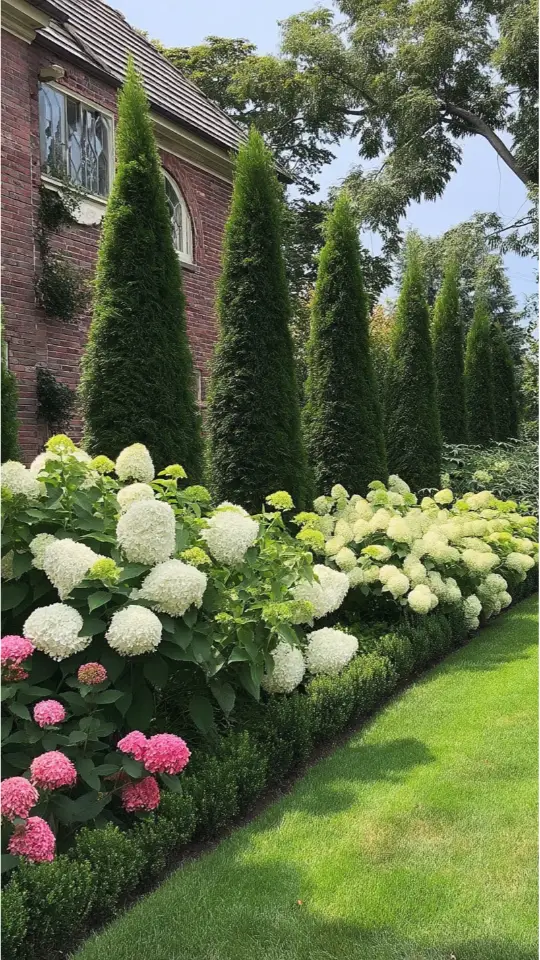
Hydrangeas thrive in well-drained soil with morning sun and afternoon shade, making care easier for me as a gardener.
This pairing works perfectly for formal gardens or cottage landscapes!
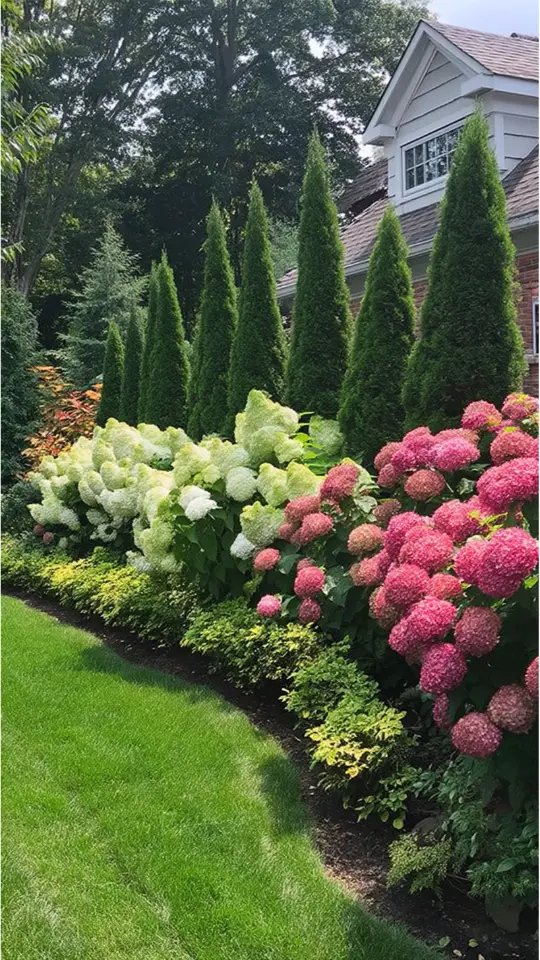
Blue
Blue hydrangeas create a stunning display along a stone border. Their vibrant color stands out, grabbing attention right away.
I make sure my soil stays acidic because it keeps the blooms bright blue. Adding blue lace cap hydrangea bushes can bring variety to the front yard.
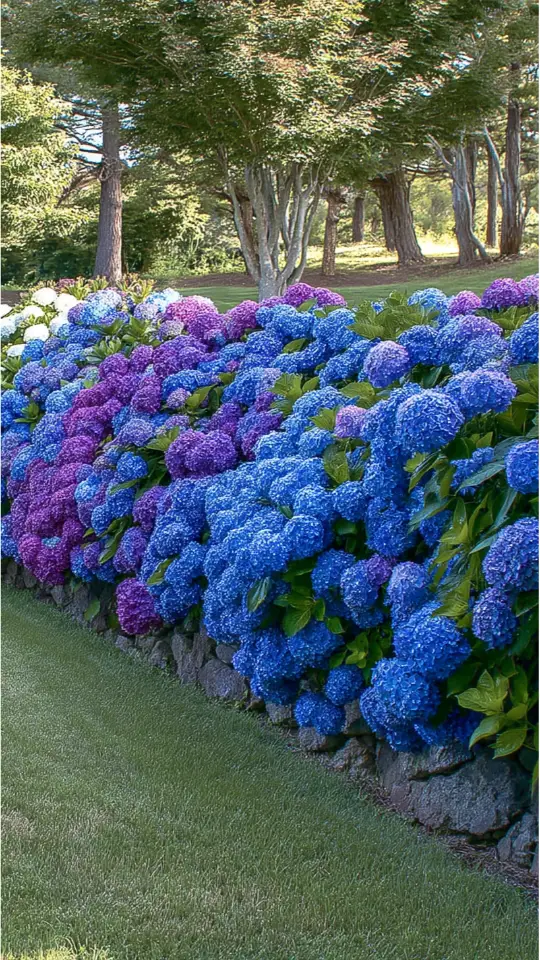
I space each plant 3 to 4 feet apart for a lush, full effect. Consistent watering during early years is key for healthy plants.
Pairing them with baby blue eyes or blue bougainvillea gives a cohesive look that feels thoughtful and balanced!
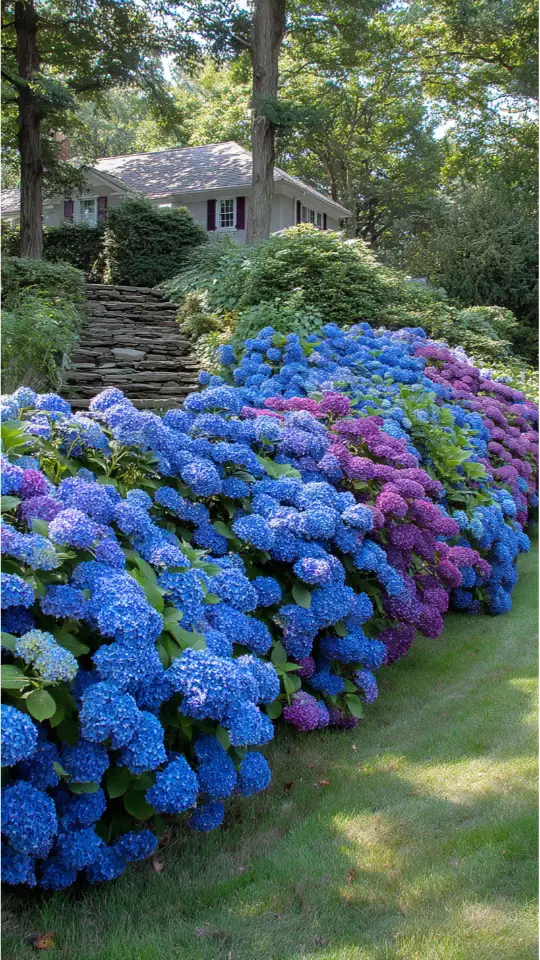
Climbing Trellis
Blue hydrangeas may steal the show, but climbing hydrangeas bring a unique touch. Their white lace cap flowers look stunning as they climb trellises, fences, or brick walls.
These plants attach with aerial rootlets and can grow up to 50 feet tall and 10 feet wide once mature.
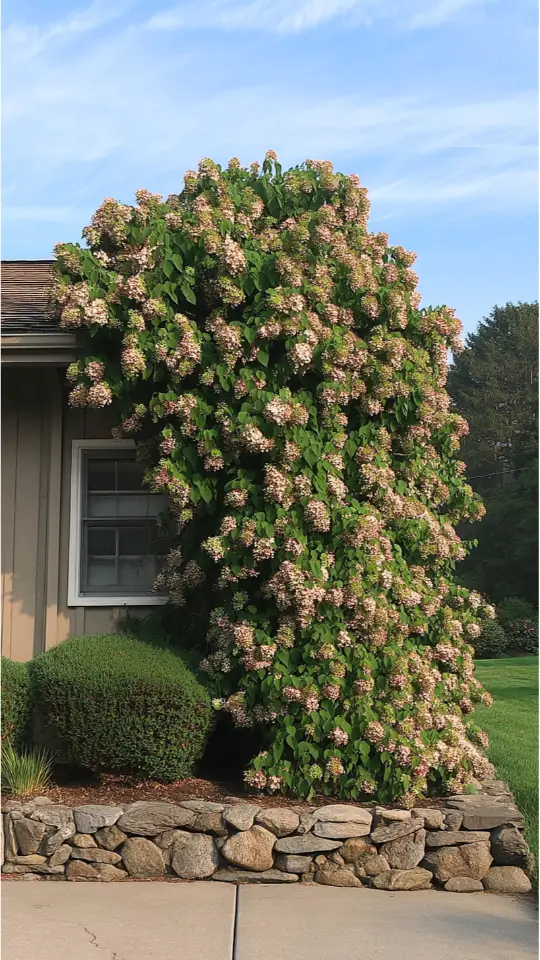
I love how glossy green leaves cover bare surfaces in spring. It takes about three to five years for them to establish and start growing significantly.
They thrive best in well-drained soil with part shade or full shade. Over time, their bark changes add character even during colder months!
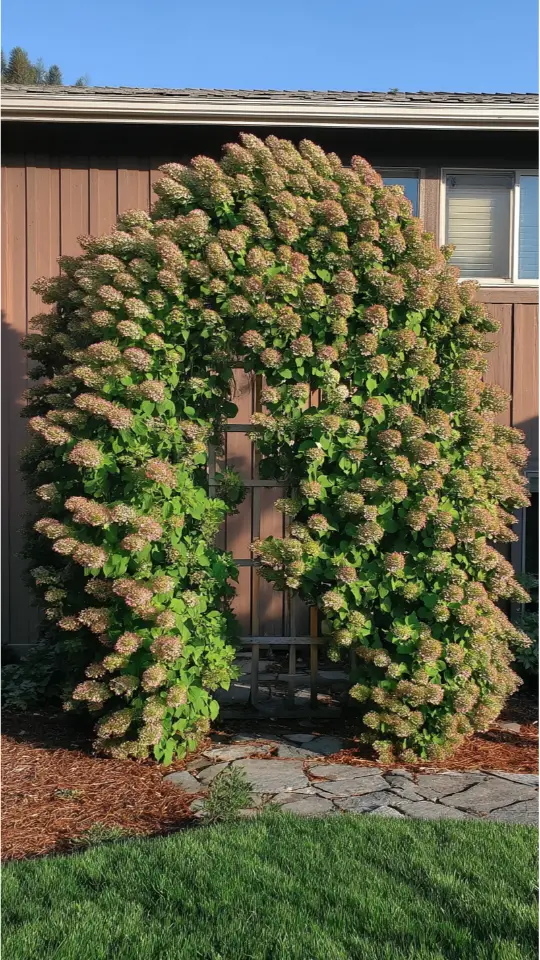
Allium
White climbing hydrangeas on trellises bring beauty to garden walls. Next, I mix purple alliums with white hydrangeas for a perfect pair.
The tall, round blooms of alliums rise above lush hydrangeas like nature’s artwork. Both plants thrive in well-drained soil and need partial sunlight.
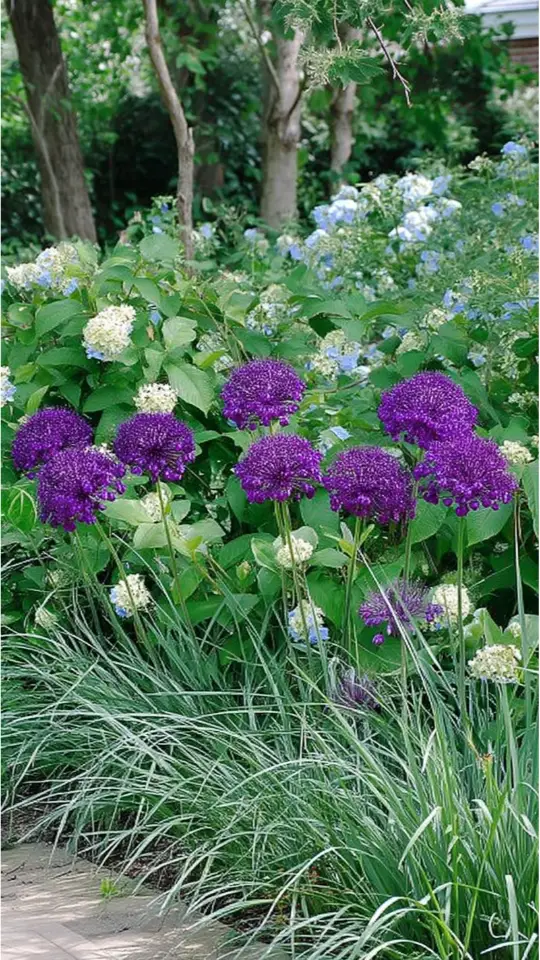
Alliums add height and keep pests away from hydrangeas. Their vibrant color attracts pollinators too, which helps gardens stay healthy.
This combination makes the space lively and eye-catching while being easy to care for.
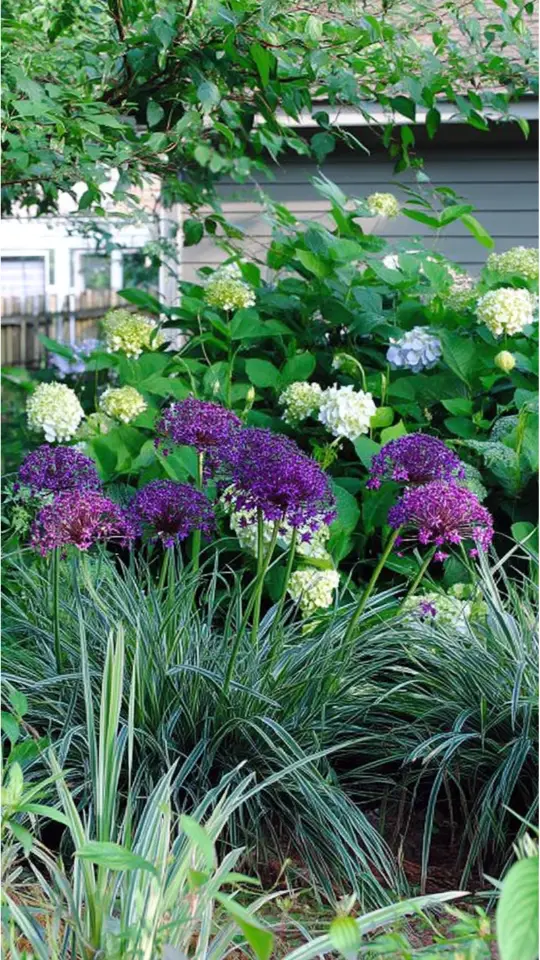
Azalea
Pink azaleas mix perfectly with colorful hydrangeas. Their blooms light up shaded garden paths in a way that feels magical.
I love how hydrangeas thrive in partial shade, making them ideal for low-light spots. The azaleas add a pop of pink, creating visual interest against the green leaves.
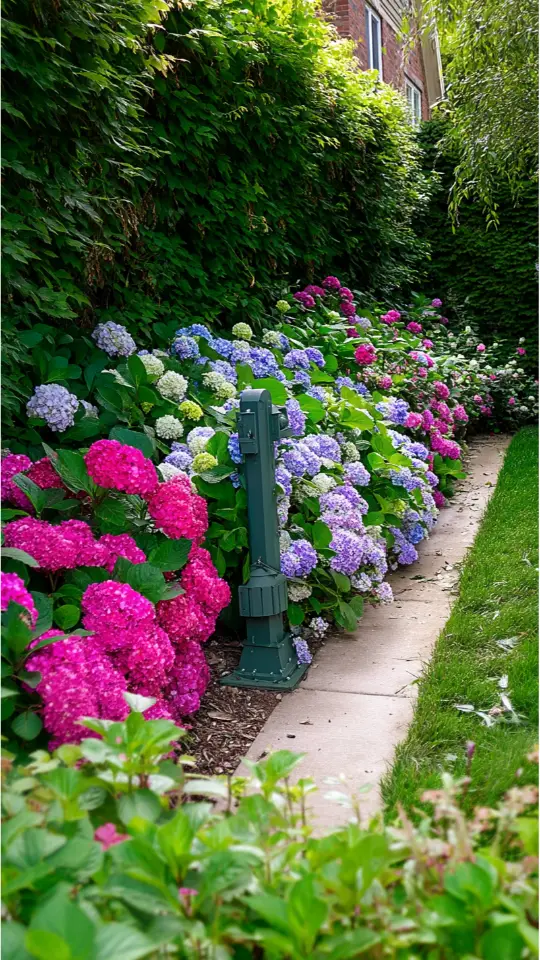
Tree-form hydrangeas make great focal points along these paths. They stand tall and proud under shady trees, drawing attention to their blooms.
Pairing them with azaleas creates hedges full of life and color while giving privacy too! Ready for more ideas? Keep reading below!
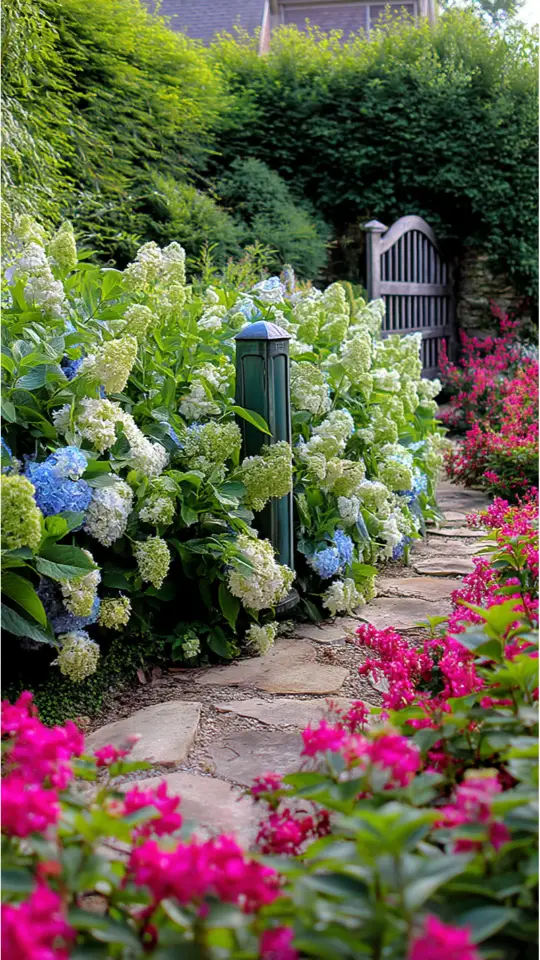
Boxwood
I love how boxwoods and hydrangeas create such a neat, elegant garden. Boxwood shrubs, with their evergreen beauty, form clean lines around colorful hydrangea blooms.
They define the space while keeping it timeless.
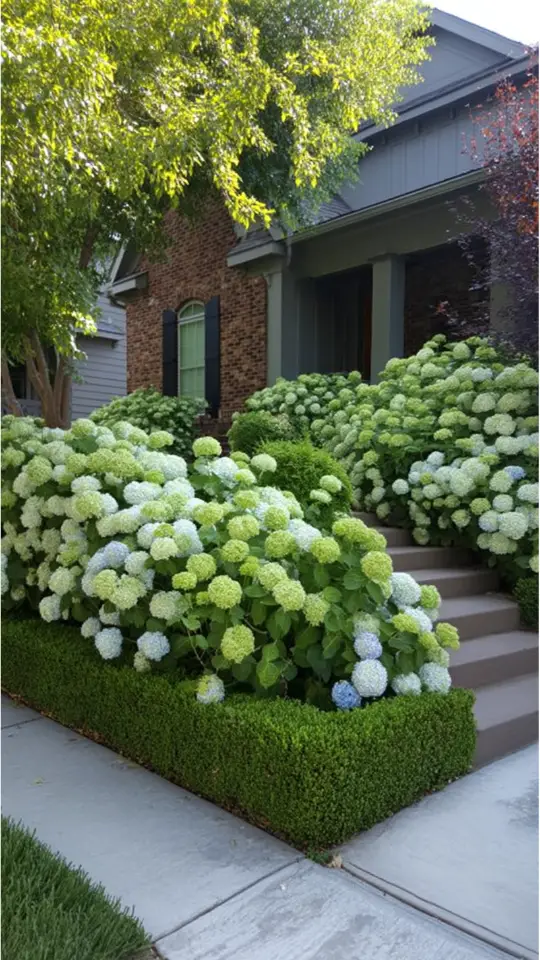
Hydrangeas stand out even more against the deep green of boxwoods. Trimmed borders give everything a polished look. This pairing works well in formal designs or cottage gardens.
Using acidic soil ensures vibrant hydrangea colors, while boxwoods thrive in fertile soil too!
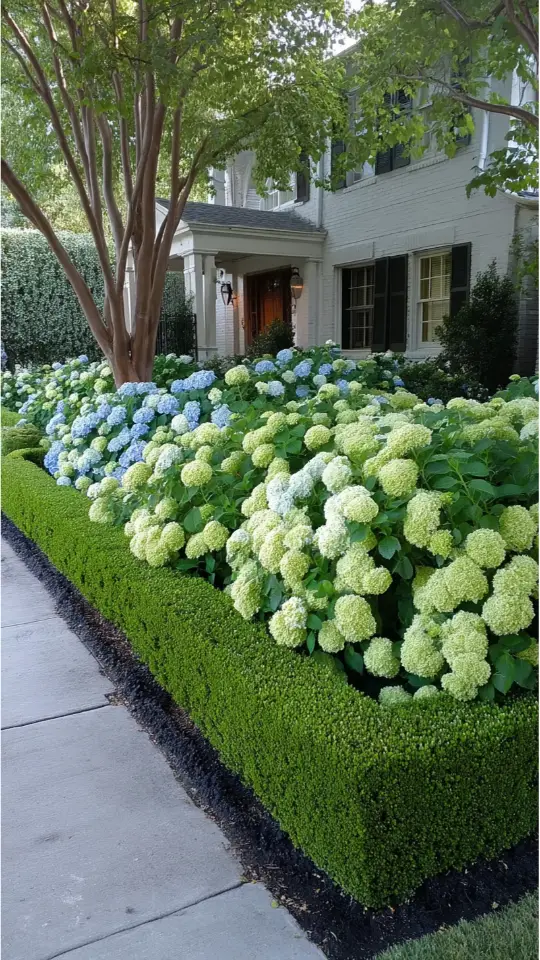
Juniper
Boxwood gives structure, but juniper adds boldness. I pair evergreen junipers with blue hydrangeas for a striking mix of textures and colors.
Junipers stay green all year, providing constant beauty. Their dark green needles highlight the bright blooms of bigleaf hydrangeas.
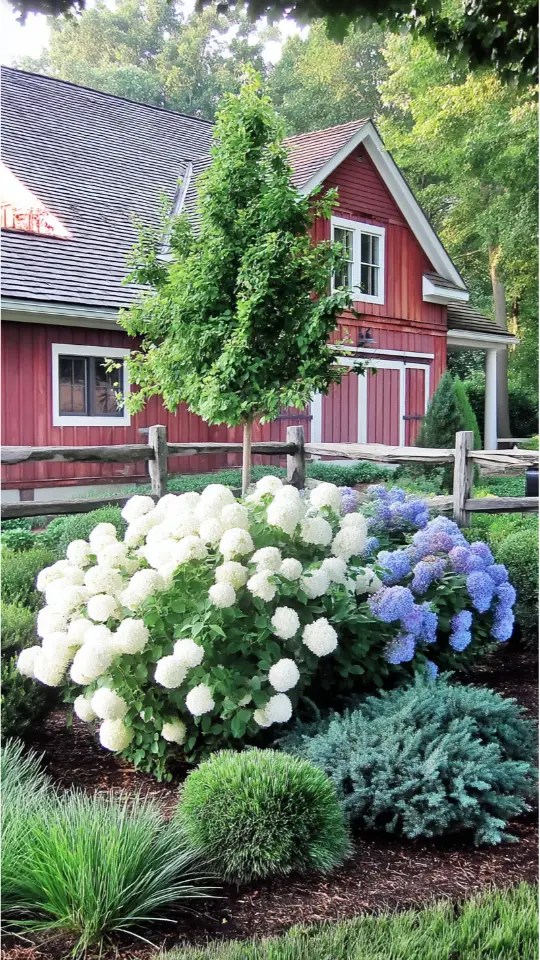
Both plants thrive in acidic soil and handle partial shade well. I like planting them together along fences or paths for a balanced look.
Adding shade-tolerant flowers below enhances the design further. These plants are easy to grow with morning sun, proper water, and good drainage!
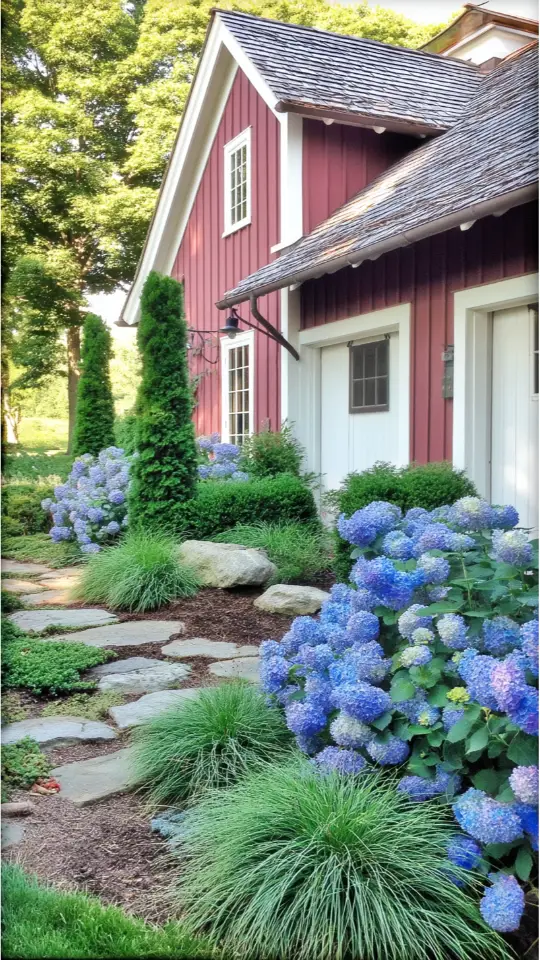
Lavender
The soft green of junipers pairs beautifully with hydrangeas. But for more vibrant combinations, lavender steals the show. Purple lavender creates striking borders around fragrant hydrangeas.
It adds color and texture to any garden bed.
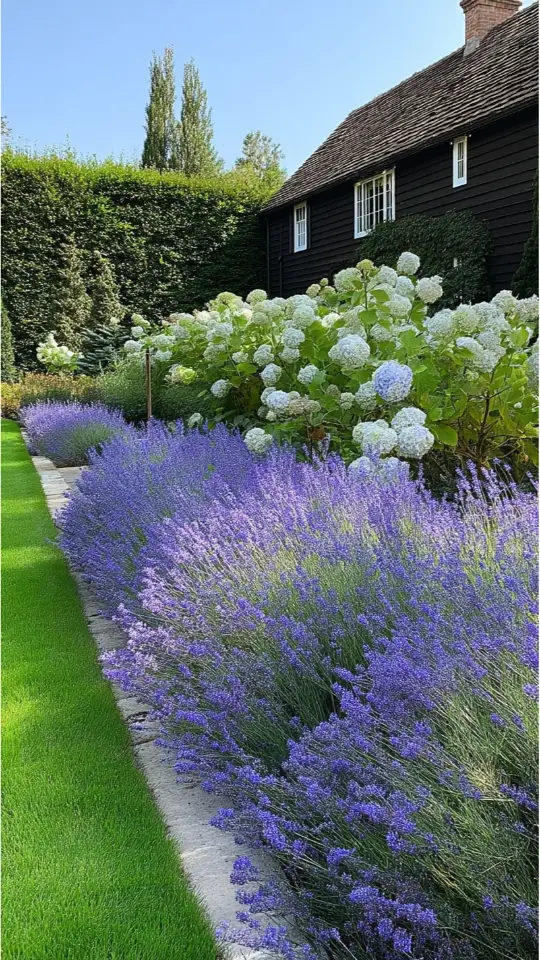
Lavender thrives in full sun, which helps it bloom brightly. Its drought tolerance also complements hydrangeas that prefer dryer spots with morning sun and afternoon shade.
This pairing improves both beauty and plant health while drawing bees and butterflies too!
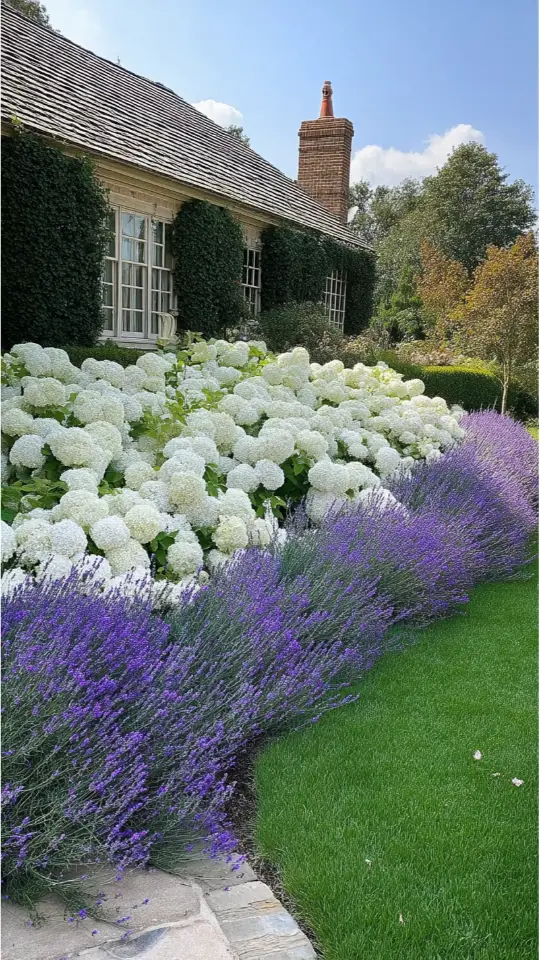
Peony
Pink peonies blend perfectly with hydrangeas. Their soft petals and fluffy shapes create a dreamy, full look in the garden. I love using pastel pink peonies beside white or pink hydrangeas for balance.
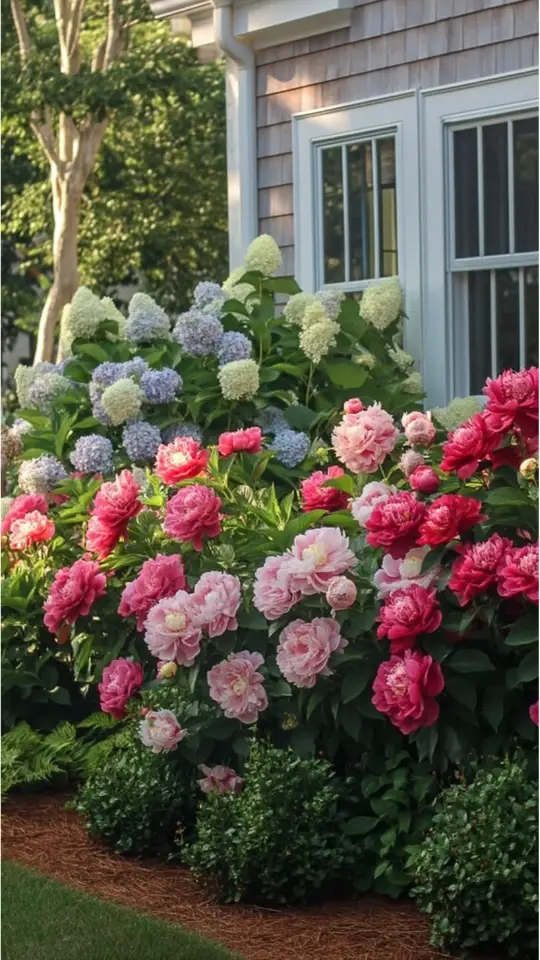
The combination looks elegant and romantic.
Both plants thrive in well-drained soil with morning sun and afternoon shade. Hydrangeas provide big blooms, while peonies add texture that feels light and airy.
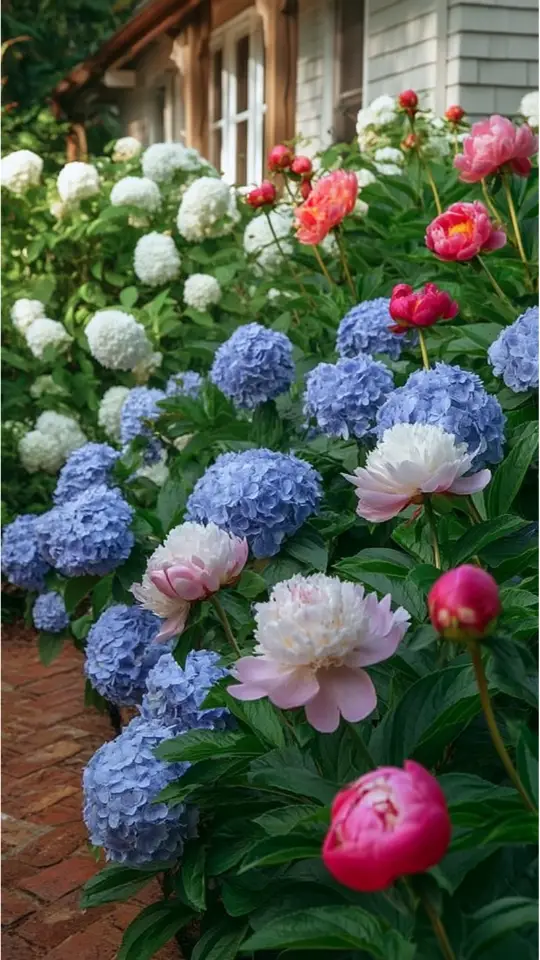
This mix works beautifully near pathways or as a stunning focal point in any yard.
Rose
Red roses and white hydrangeas make a dreamy garden pair. I love how the vibrant red of OSO EASY DOUBLE RED ROSES stands out next to INCREDIBALL SMOOTH HYDRANGEAS.
This duo blooms from summer to fall, keeping the garden lively for months.
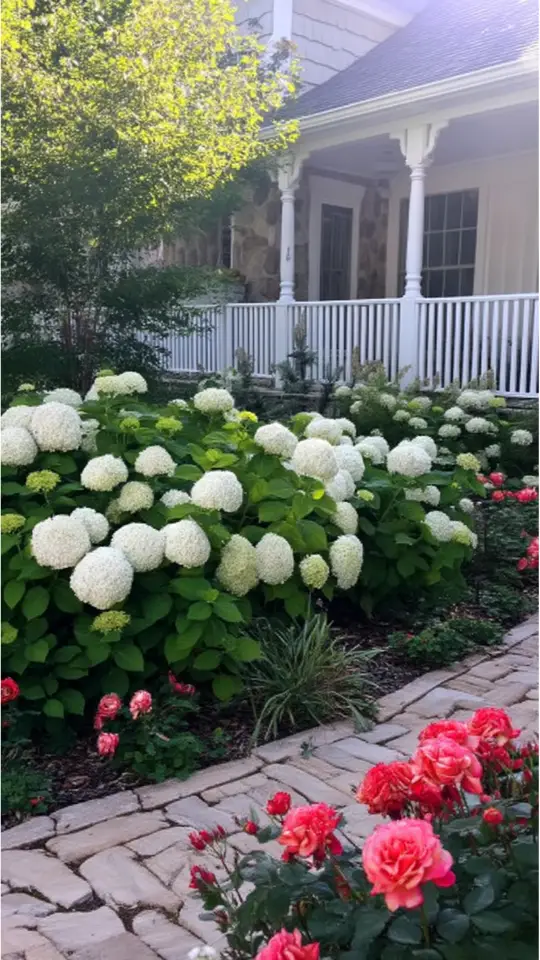
FAIRYTRAIL BRIDE CASCADE HYDRANGEAS with REMINISCENT PINK ROSES add soft, romantic charm too.
For something brighter, LIMELIGHT PRIME PANICLE HYDRANGEAS mix well with OSO EASY LEMON ZEST ROSES.
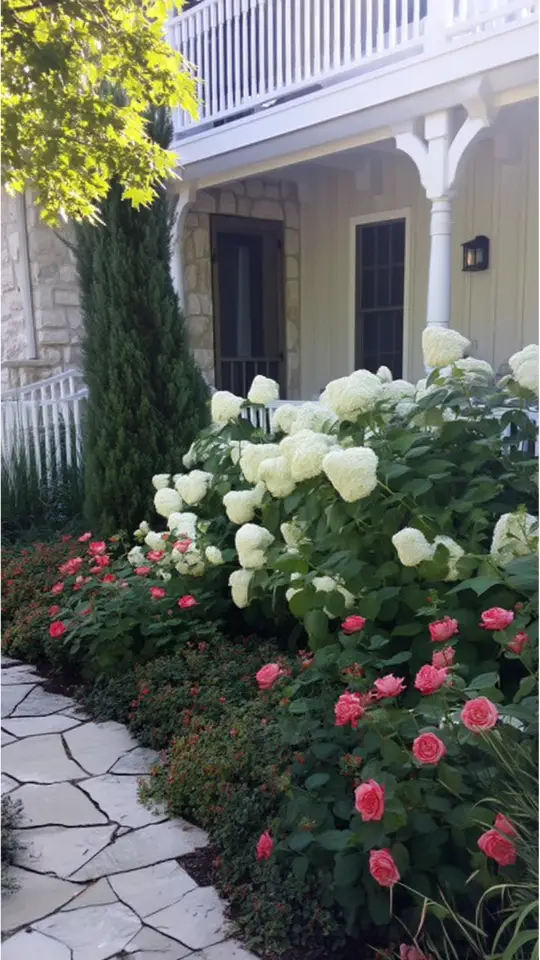
These pairs thrive in well-drained soil under morning sun with afternoon shade. Their colors glow against other greenery and create stunning views!
Tall Grass
Tall grasses like Blue Fescue add softness near white hydrangeas. They create layers that look natural but polished. This pairing looks best in well-drained soil with some shade.
Both hydrangeas and ornamental grass thrive in partial sun, so morning sunlight works perfectly.
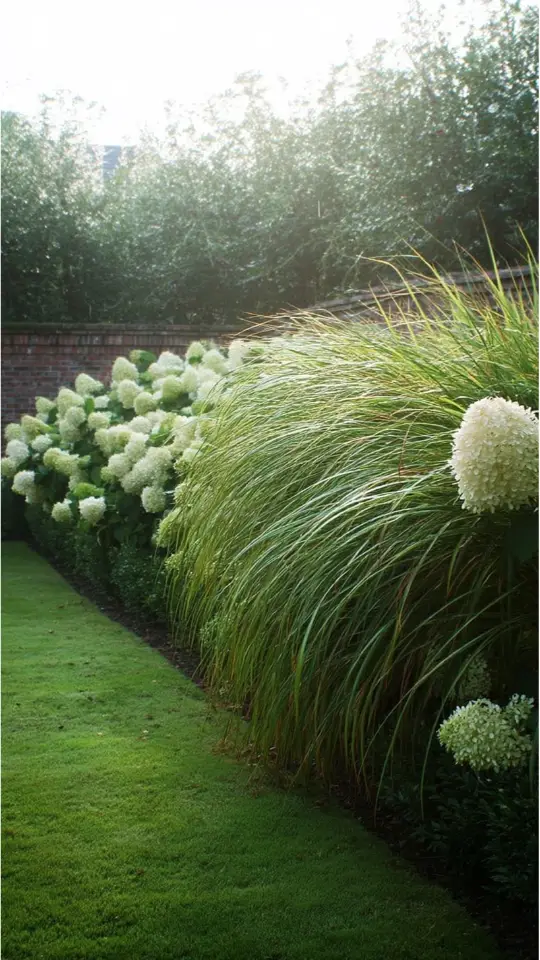
I love how the long-lasting hydrangea blooms pop against the graceful movement of tall grass. Hakone Grass is another great choice for extra texture and charm.
Together, they keep the garden vibrant even late into the season!
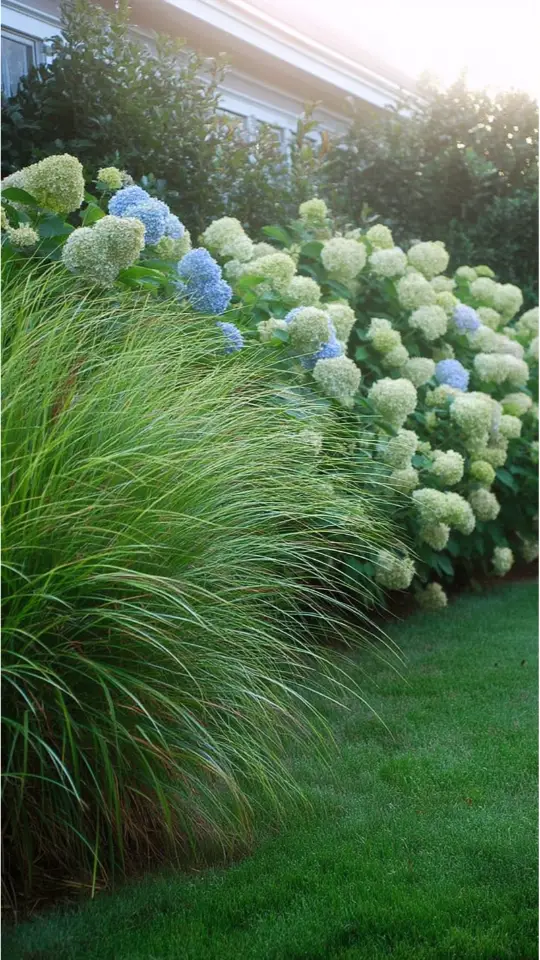
Border
A white hydrangea hedge looks stunning along a brick path. It creates a soft, formal entrance to any garden space.
I like how these blooms brighten the walkway and guide visitors toward gates or porches. Planting them close together makes the path feel cozy and inviting.
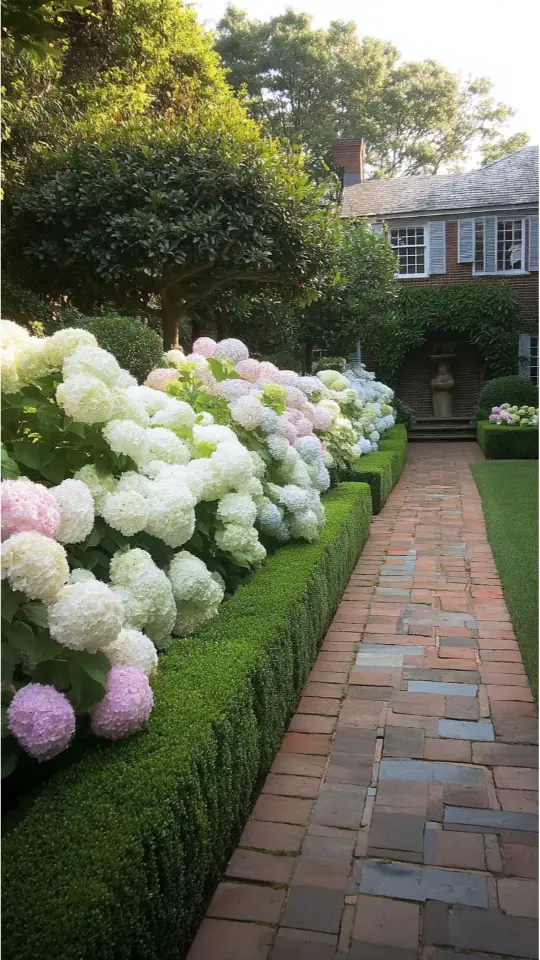
These hedges work well in designs with hardscapes too. The flowers soften edges while adding charm to structured layouts.
For best results, I choose rich soil with good drainage and give these plants some morning sun and afternoon shade.
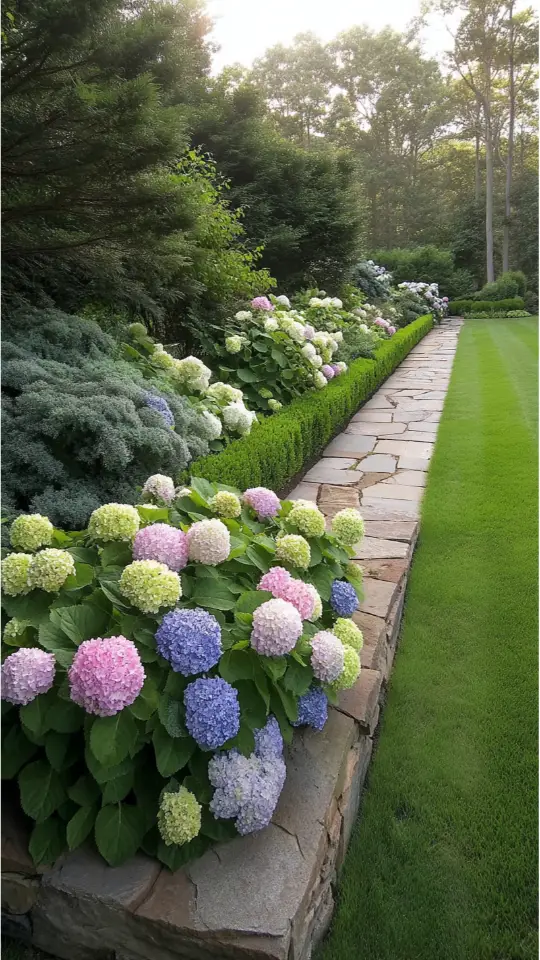
This keeps their blooms fresh all season long!
Driveway
Hydrangeas create a colorful and warm welcome along driveway edges. Their blooms can reach up to 3–4 feet wide, so I always make sure there’s enough room for them to grow.
White hydrangeas thrive in full sun, while blue or pink ones need more shade and extra moisture.
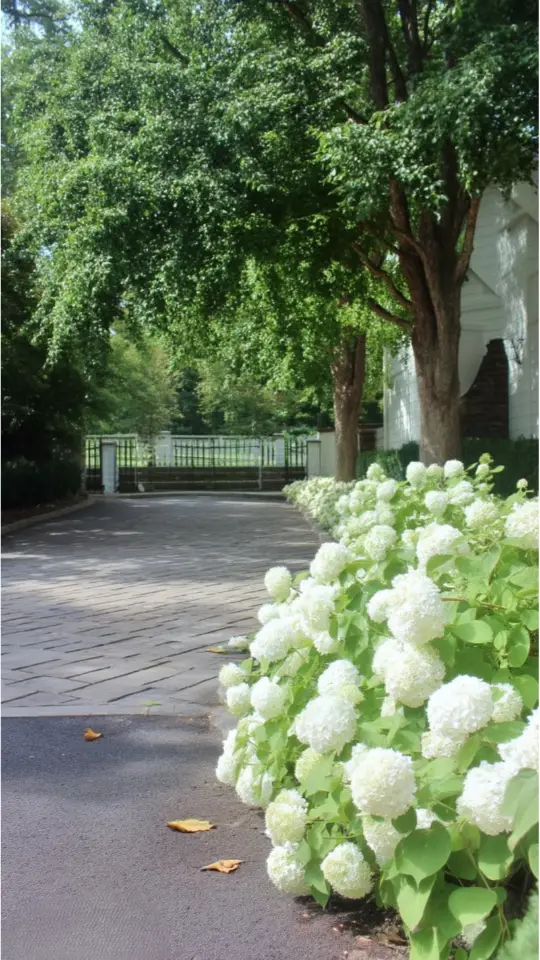
They love well-drained soil with the right pH balance too.
Planting these flowers makes any driveway look fresh and inviting. Seasonal colors brighten up the space, showing off nature’s beauty year-round as you plan your garden design near fences or pool areas next!
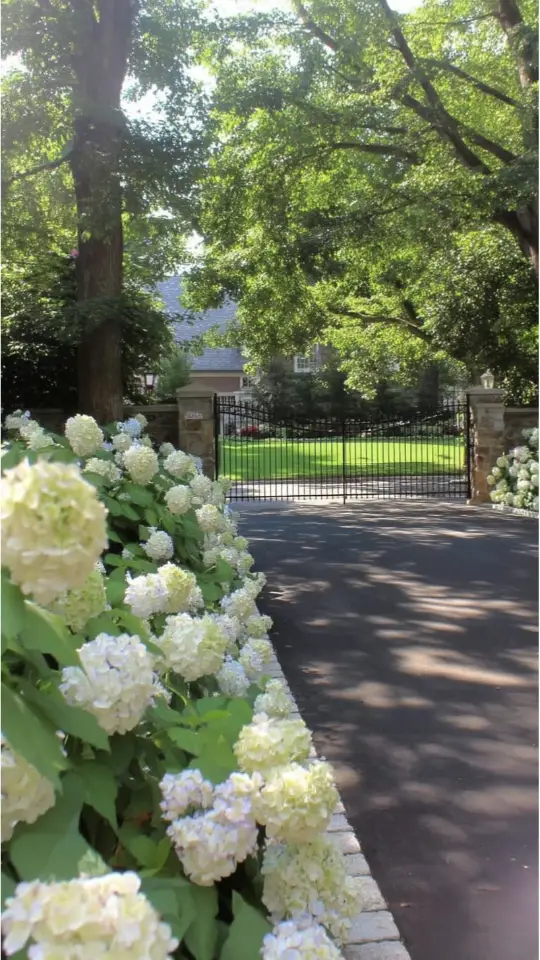
Flower Arch
A lavender hydrangea archway turns any garden walkway into a magical entry. The soft lavender blooms draw the eye and create a peaceful, inviting vibe.
I love how these arches add both structure and beauty to outdoor spaces.
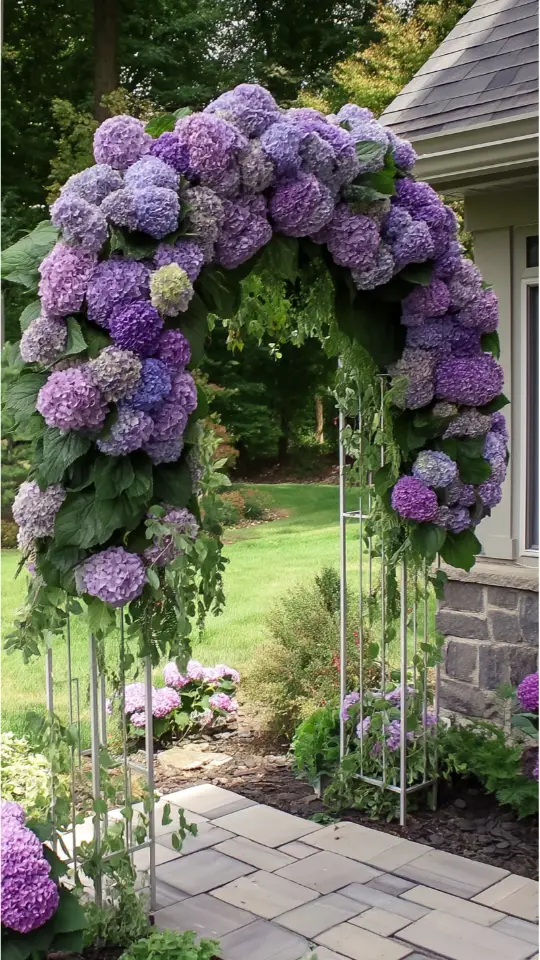
Such an arch works perfectly for leading to quiet spots like patios or hidden gardens. It frames the path while giving it character.
Planting in well-drained soil with morning sun helps these flowers thrive.

Mixing them with rich potting mix boosts their fertility too!
Hanging Basket
That lavender hydrangea arch steals the show, but a hanging basket can create magic too. Bright blooms in flat-bottom baskets catch everyone’s eye on patios or porches.
I love how they stand out in both full sun and afternoon shade.
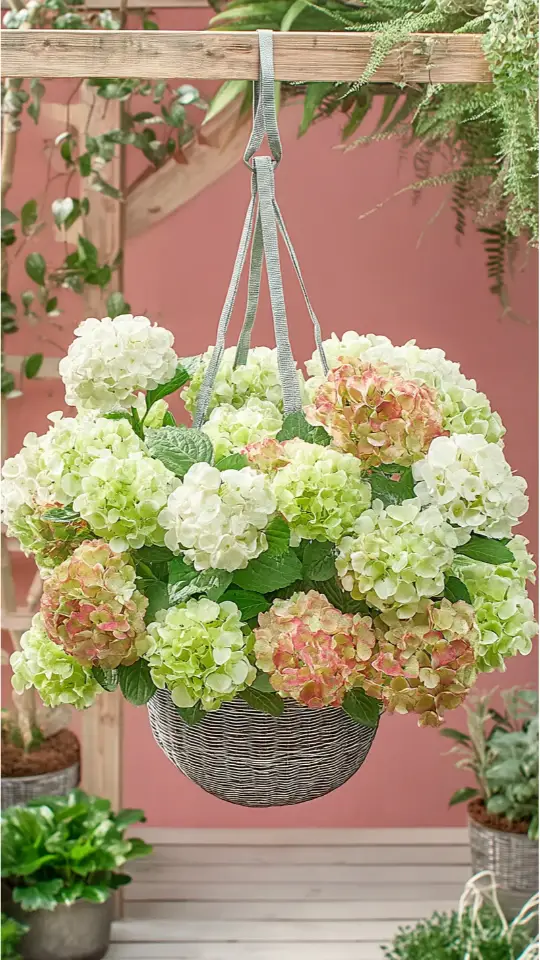
These baskets work as table centerpieces too! I saw a Facebook group of 1.6 million members rave about them. One post got 17 likes and shares quickly followed.
It shows how much gardeners enjoy these unique displays around their homes or outdoor spaces!
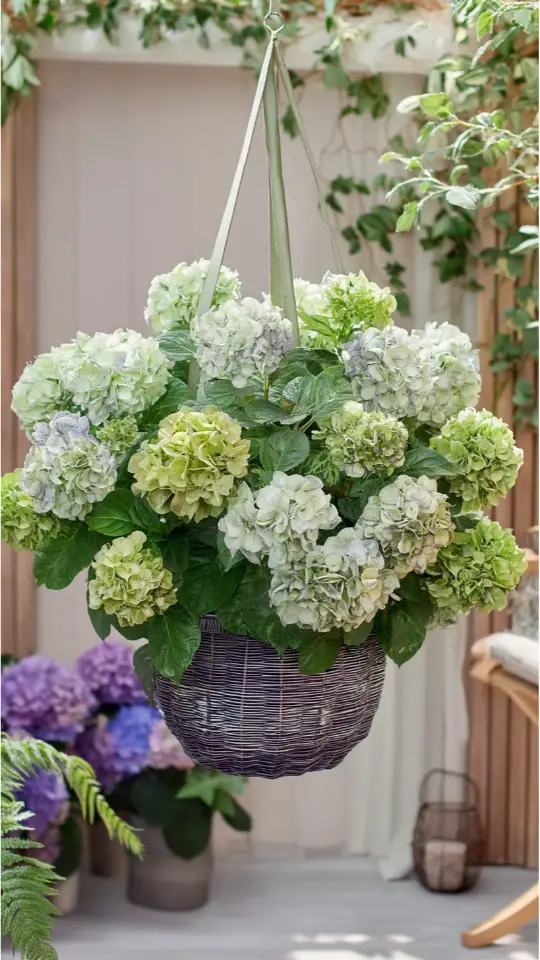
Along Fence
Blue hydrangeas work great along a fence. Their full blooms and dense leaves create natural privacy while looking beautiful all season long.
I love how the bright flowers add color to the yard, especially in shaded spots.
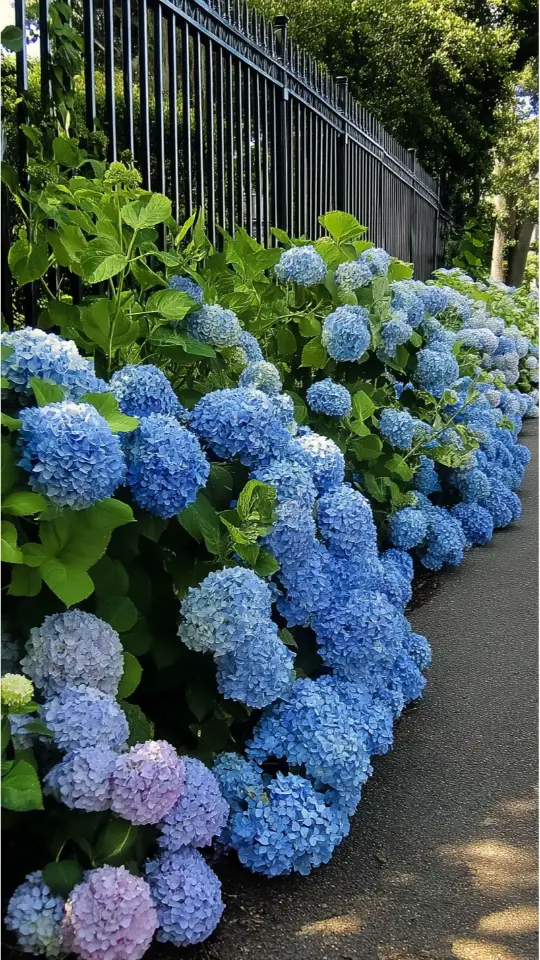
They grow well in partial shade with morning sun and afternoon shade.
Planting them near fences helps tie together garden designs. These shrubs thrive best in well-drained soil rich in nutrients. Adjusting soil pH can even change their bloom colors!
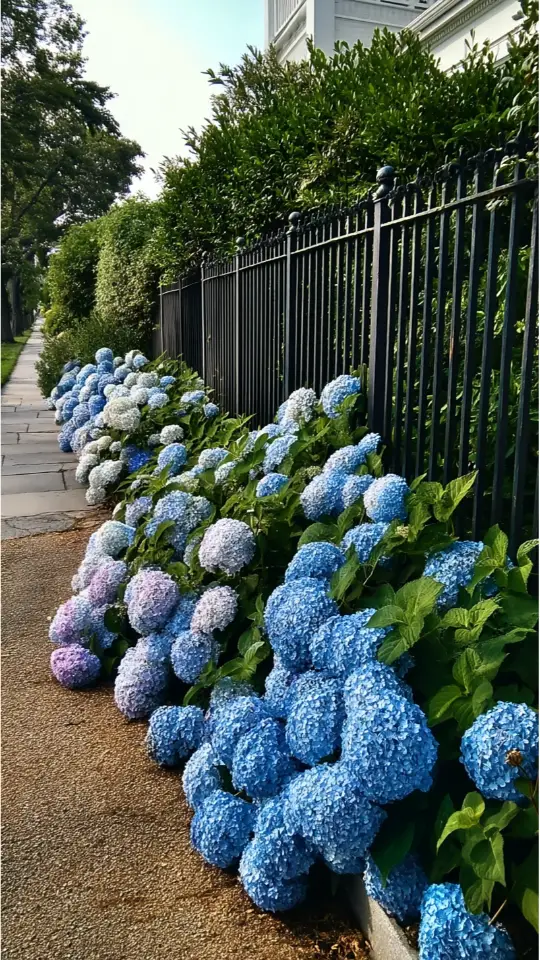
Acidic soil creates blue shades, which makes these perfect for those vibrant pops of color along your fence line.
Pool
Purple hydrangeas look stunning around pools. Their bright blooms and lush leaves soften the hard lines of pool edges. I love how they add color while keeping the space calm and peaceful.
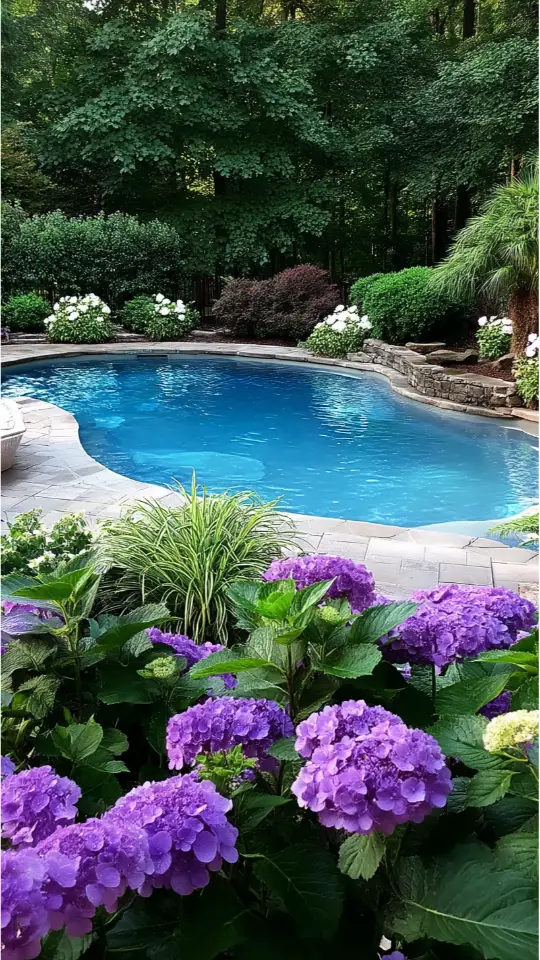
Paniculata hydrangeas work great for summer borders. They thrive in full sun with well-drained soil, making them perfect near water features.
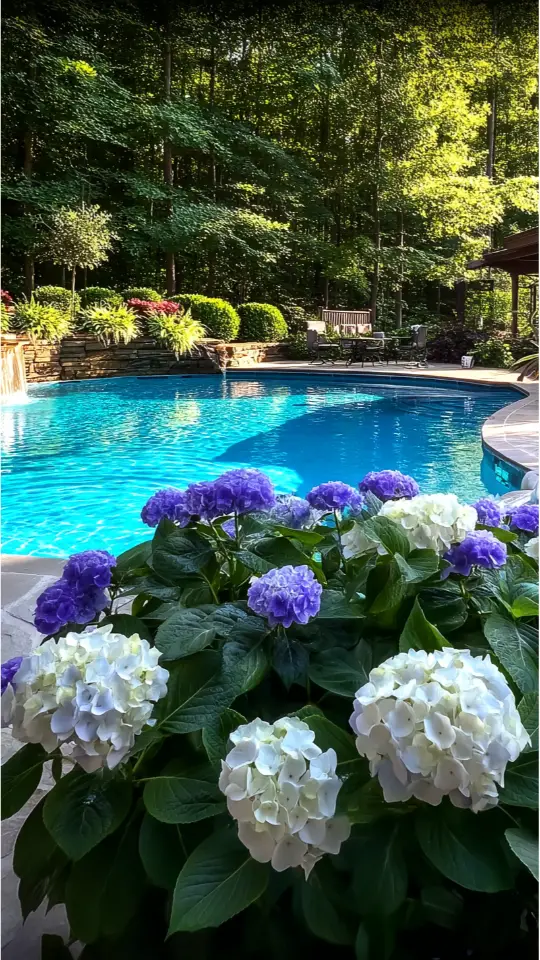
Proper care is key, like fertilizing and pruning regularly to keep them healthy and vibrant all season long!
Incrediball
I love how Incrediball Hydrangeas take over a garden with their massive blooms. Each flower cluster can grow up to 12 inches wide, starting as creamy white and fading to light green.
These hydrangeas stand about 4-5 feet tall and wide, making them perfect for borders or focal points in my yard. Their bold look brightens up any space during the heat of mid-summer.
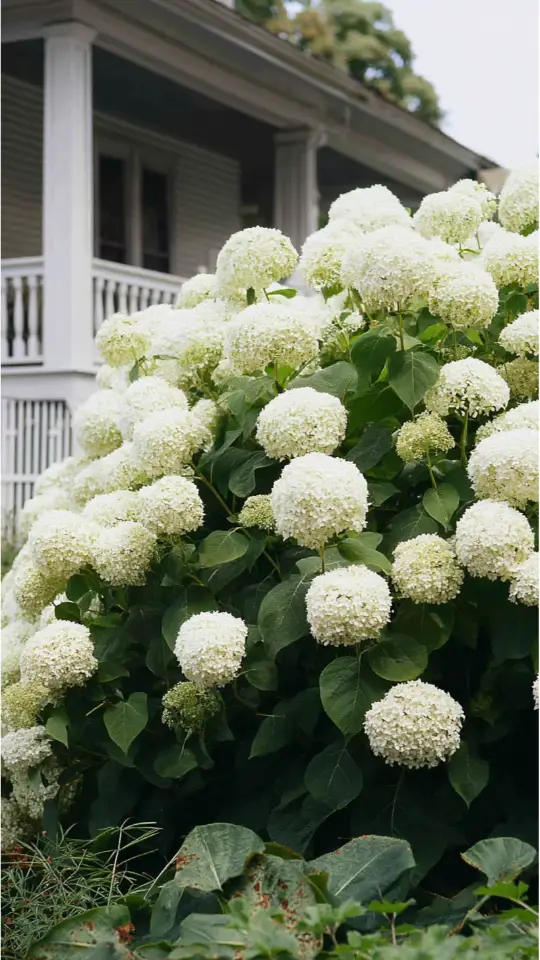
These smooth hydrangeas handle colder climates well since they thrive in USDA zones 3–8. I prune mine in late winter or early spring to keep them lush and healthy.
Planting them in full sun with well-drained soil gives me the best results every season!
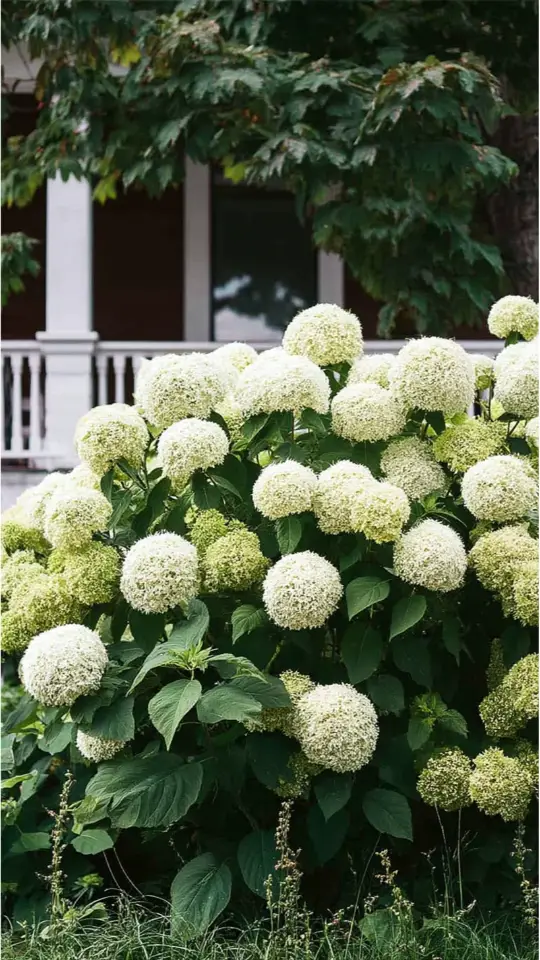
Limelight
Limelight hydrangeas are perfect for adding charm to summer gardens. Their blooms start as pale green, change to creamy white, and finish with dusty rose or burgundy tones.
These plants thrive in full sun to partial shade and need rich, well-drained soil. I space mine 84–96 inches apart for healthy growth.
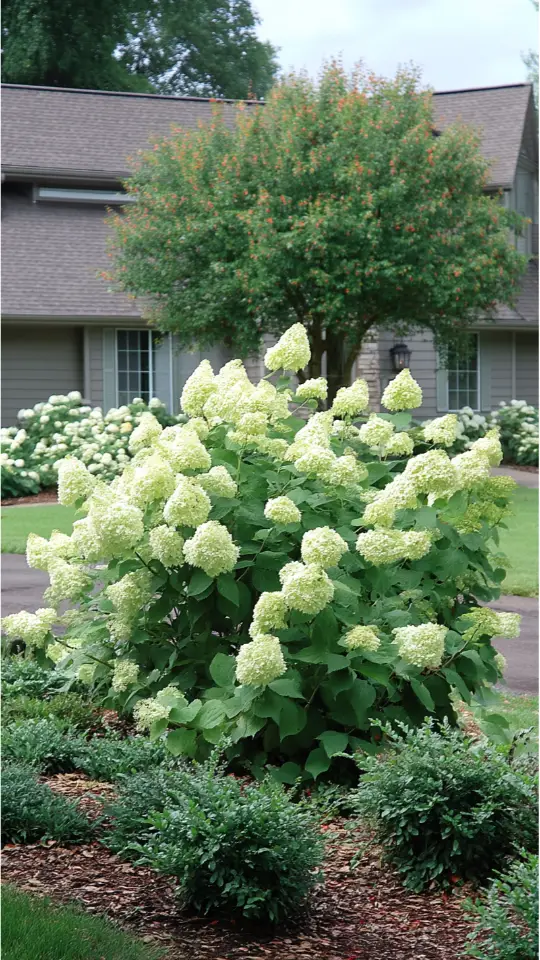
They grow best in zones 3–9 and should be planted in early spring or fall. The large blooms work great for cutting and drying too!
These versatile flowers pair nicely with other garden favorites like ornamental grasses or bigleaf hydrangeas.
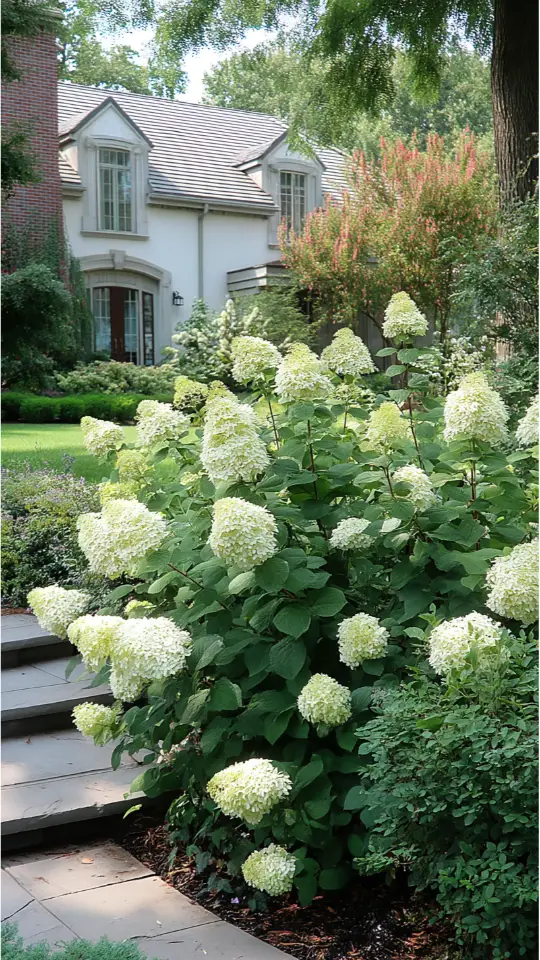
Modern
I like using geometric beds for modern garden designs. Hydrangeas bring visual balance and color to clean, straight lines in these spaces.
Their bold blooms pop against sleek paths or neutral stones.
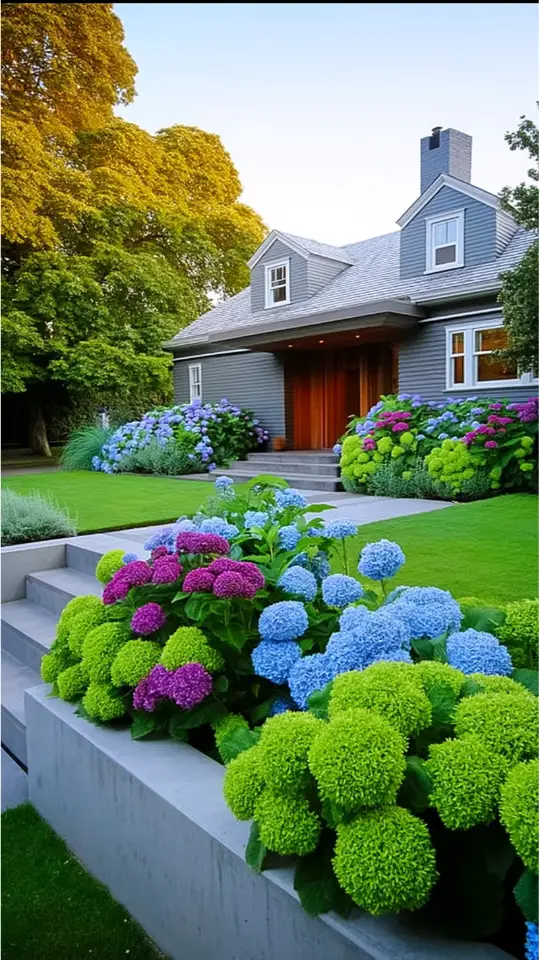
Bright hydrangea varieties work well with contemporary home styles. They add texture while keeping the design simple and fresh.
These gardens look great in full sun or with some afternoon shade, making it easy to maintain their beauty.
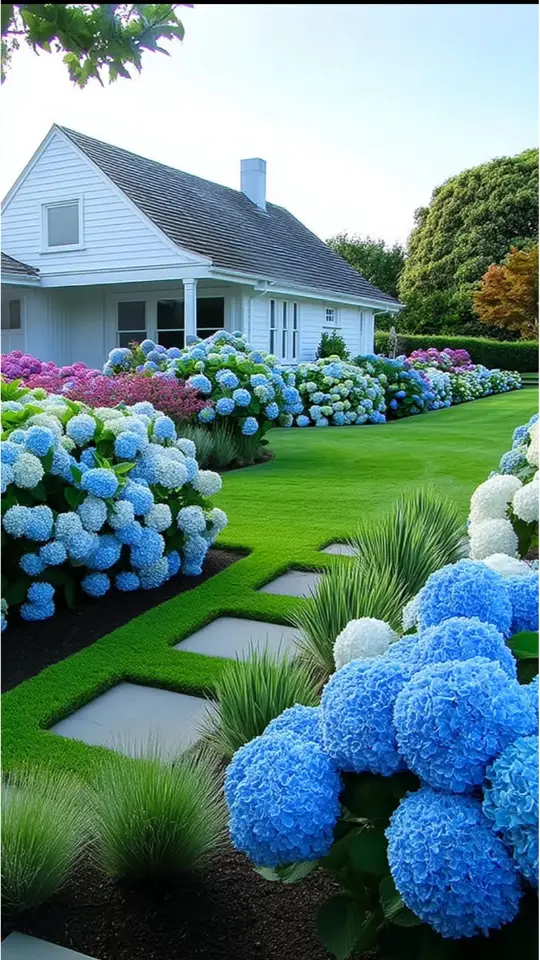
Oak Leaf
Modern beds may fit a sleek style, but shady gardens crave oakleaf hydrangeas. These beauties love dappled shade under big backyard trees and thrive in USDA zones 5–9.
Their creamy white blooms turn pink as they age, adding soft color to the space.
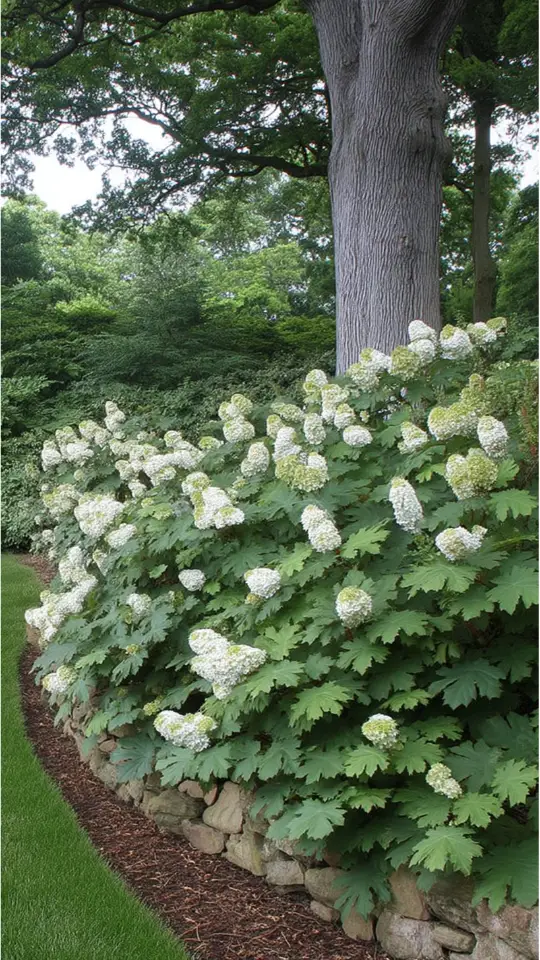
This hydrangea grows well in well-drained soil with morning sun and afternoon shade. The drought-tolerant nature makes it hardy during dry spells.
I enjoy drying its mature blooms for fall arrangements, which look stunning indoors too!
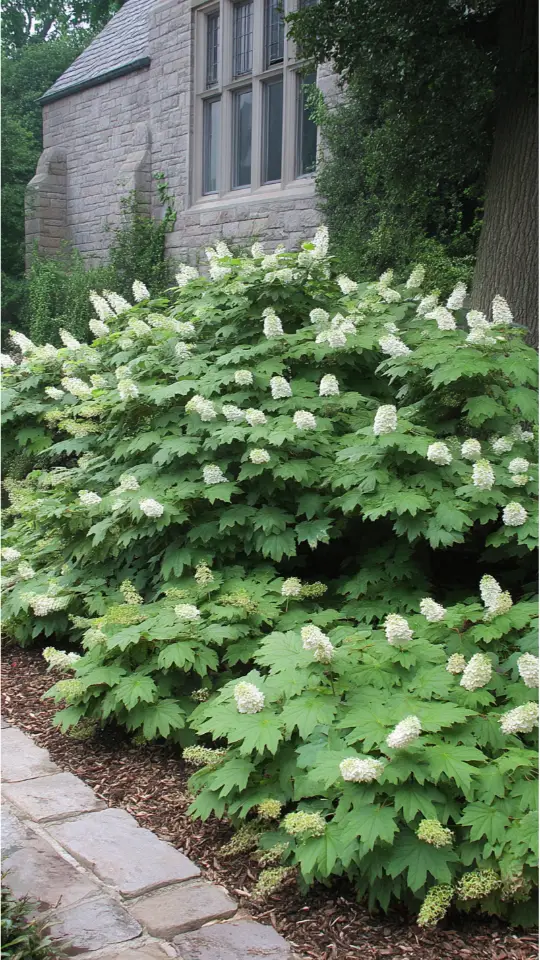
Panicle
Panicle hydrangeas thrive in full sun and well-drained soil. These low-maintenance plants can grow 6 to 8 feet tall.
I enjoy how their creamy white blooms turn pink or red as summer progresses, adding fresh shades to the garden.
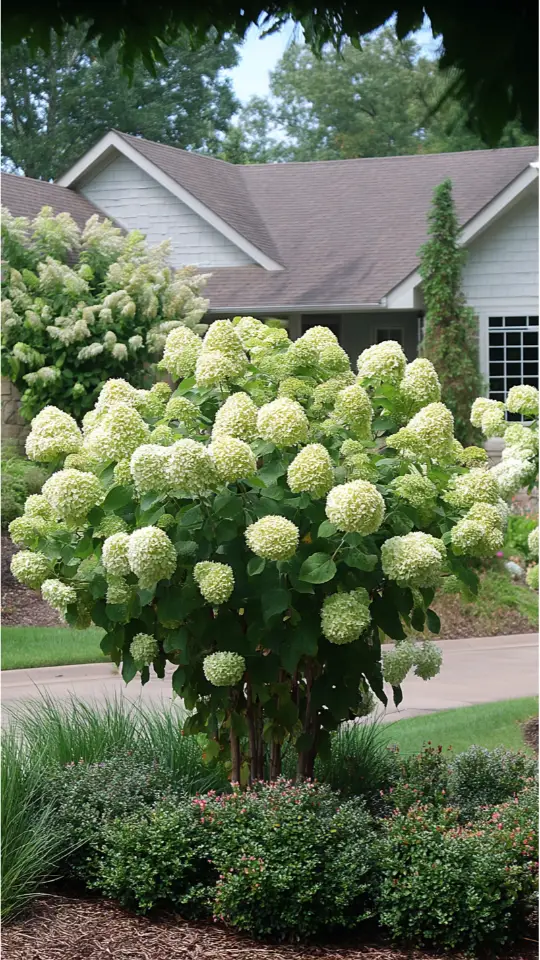
Dwarf varieties like Little Lime fit nicely into small spaces.
They bloom even in USDA zones 3 through 8, sometimes up to zone 9. Their height brings structure and catches attention in a flower bed.
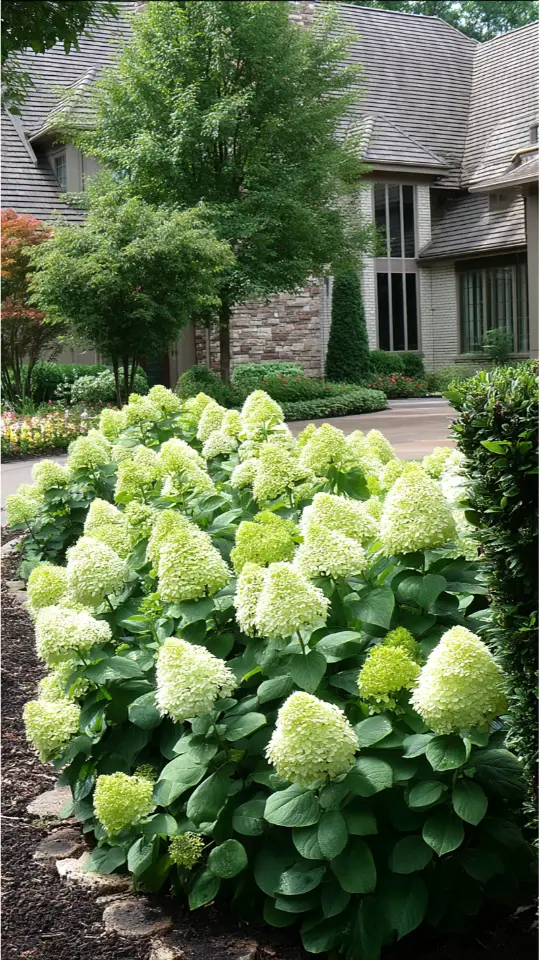
I plant them near ornamental grasses for texture or pair them with smooth hydrangeas for variety. Next, explore Quick Fire Hydrangea Landscaping!
Quick Fire
Pink Quick Fire hydrangeas bloom for over three months in summer. The flowers start creamy white and deepen to berry pink as the season goes on.
I love how these shrubs grow up to 6–8 feet tall and spread about 5–6 feet wide, filling spaces beautifully.
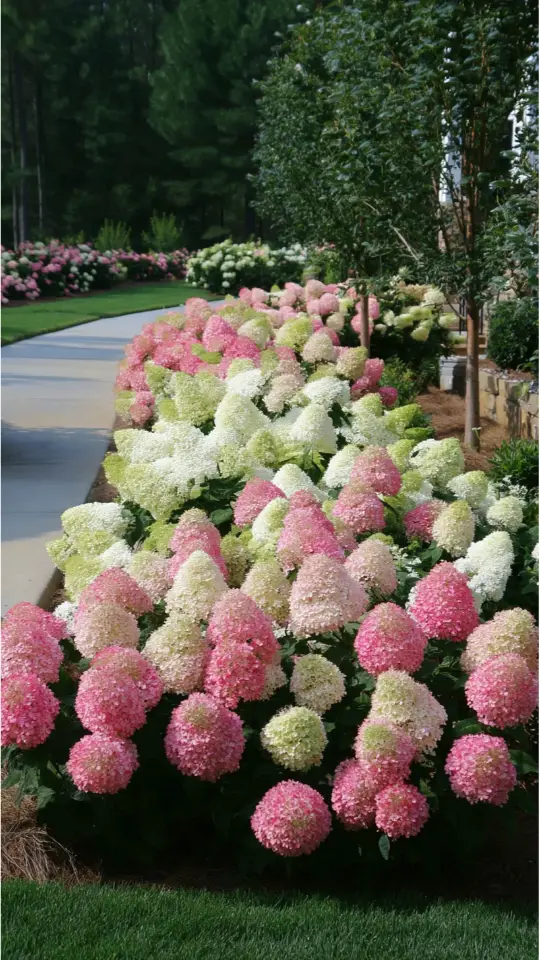
They work perfectly along driveway borders or in mass plantings. I prune mine in late winter or early spring to keep them healthy and full of blooms.
These vibrant flowers thrive best with morning sun, well-drained soil, and a little care during the warmer months!

Russian Sage
Quick fire hydrangeas light up driveways, but Russian sage takes center stage with its tall, airy blooms.
I love how the purple-blue flowers of Russian sage frame white hydrangeas in my garden. Together, they create a stunning summer scene.
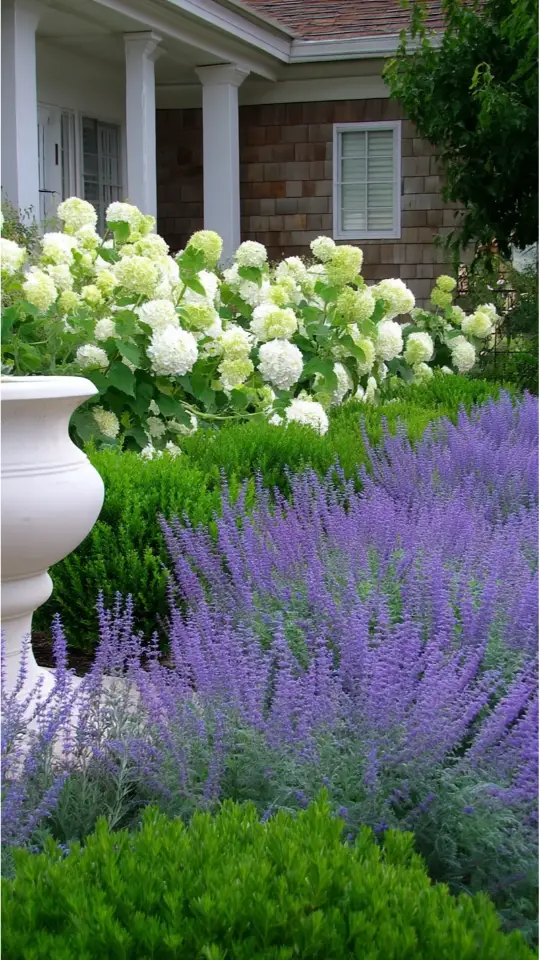
Russian sage grows 4 to 6 feet tall and thrives in full sun or partial shade. It pairs well with hydrangeas that prefer morning sun and afternoon shade.
Both plants need well-drained soil and little watering once established.
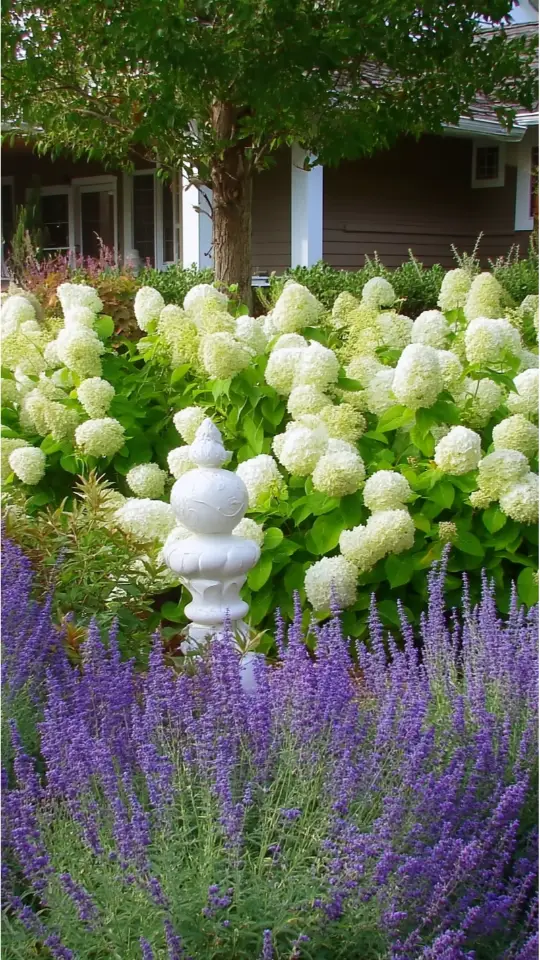
Pollinators flock to the blooms, adding life to the garden while keeping it low-maintenance.
Conclusion
Hydrangeas transform any garden into a colorful oasis. From bold blues to soft whites, these blooms offer endless options for creativity. Pair them with roses or lavender for extra beauty.
They thrive in good soil and love morning sun with afternoon shade. With a little care, your yard can burst with life all season long!
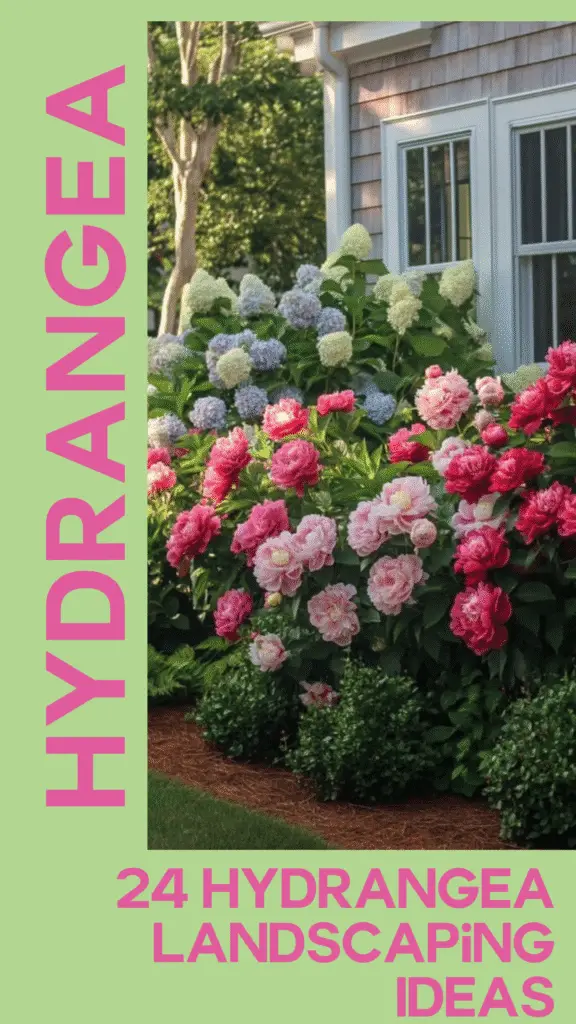
FAQs
1. What are the best conditions for growing hydrangeas?
Hydrangeas grow well in well-drained soil with morning sun and afternoon shade. Some varieties, like panicle hydrangeas, can handle more sun.
2. How do I choose the right hydrangea variety for my garden?
It depends on your space and needs! Bigleaf hydrangeas like acidic soil, while smooth hydrangeas thrive in most conditions. Limelight hydrangea is great for bold color.
3. Can I grow hydrangeas in containers?
Yes, container gardening works well with smaller varieties of hydrangea macrophylla or French hydrangeas. Use good potting soil and water often.
4. How should I care for my hydrangeas to avoid pests?
Use integrated pest management (IPM) methods like insecticidal soap to manage pests naturally. Keep weeds away and check plants regularly.
5. When should I prune my hydrangeas?
Prune after they bloom if needed but check your type first! Panicle and smooth varieties can be pruned differently than bigleaf or French types depending on their growth cycles.

